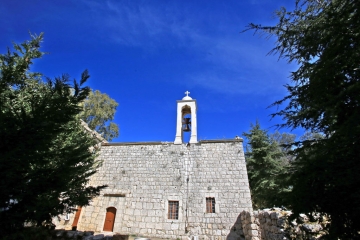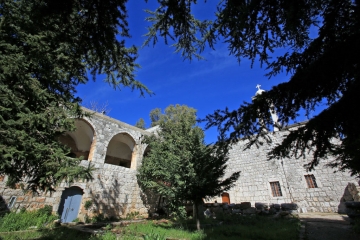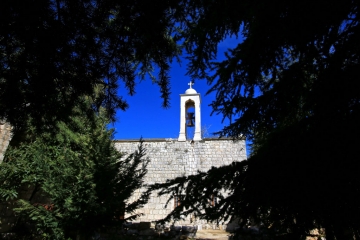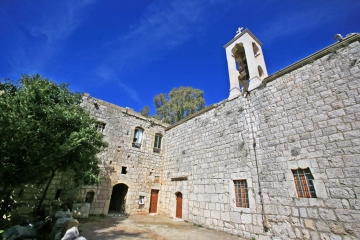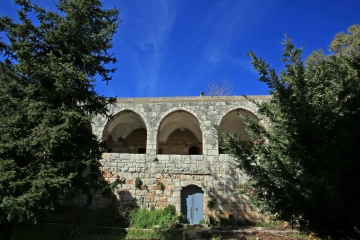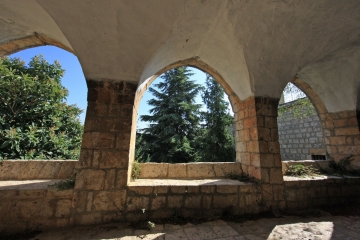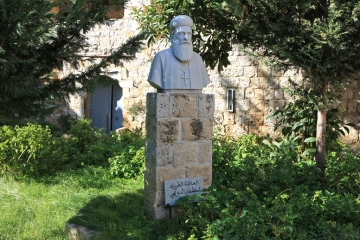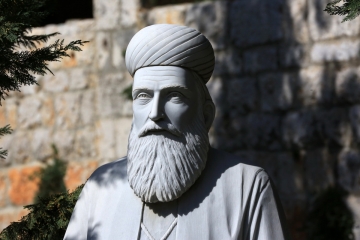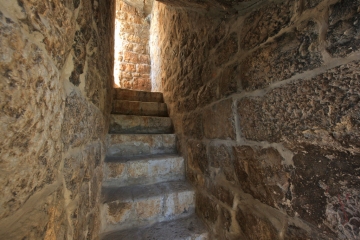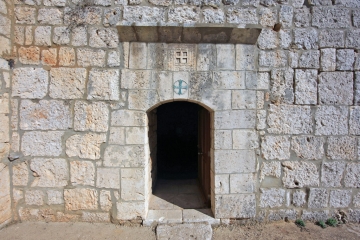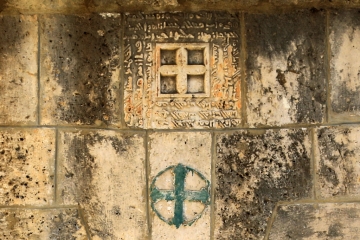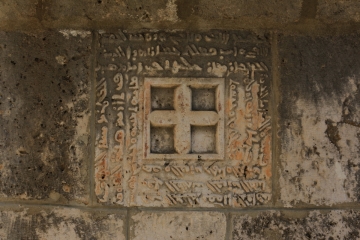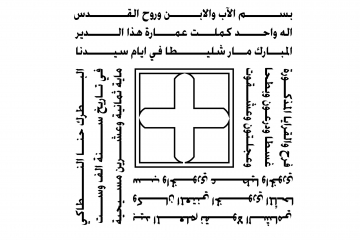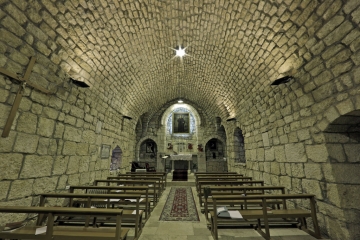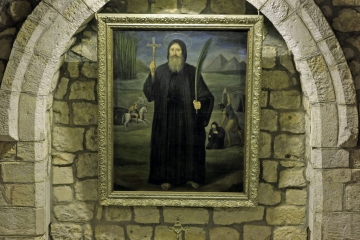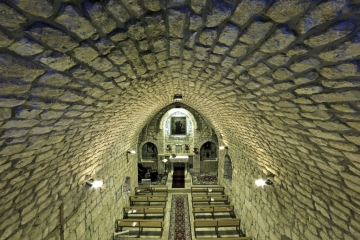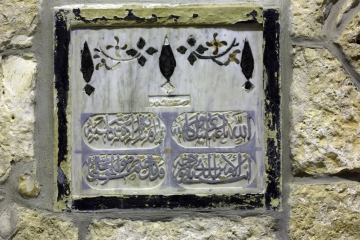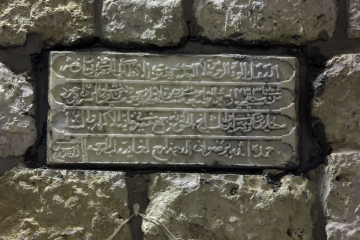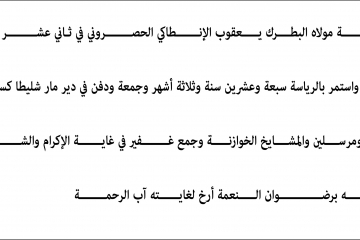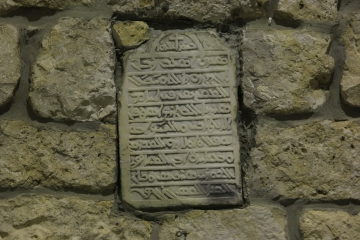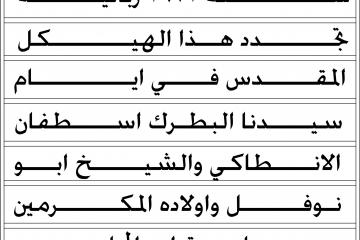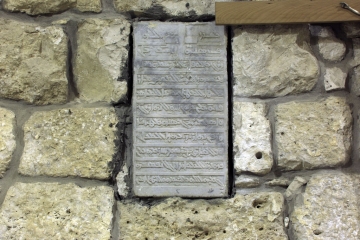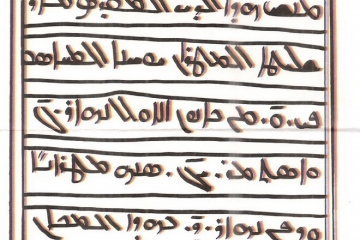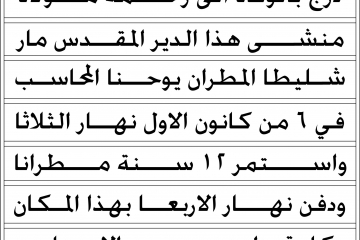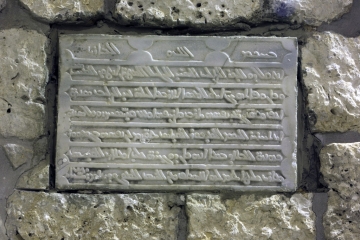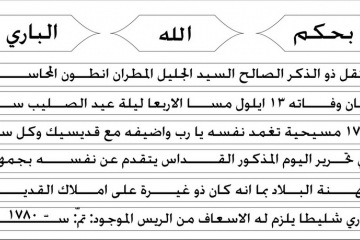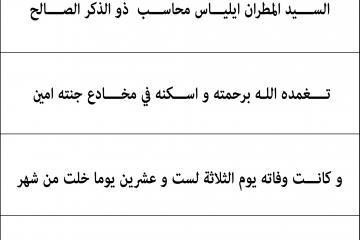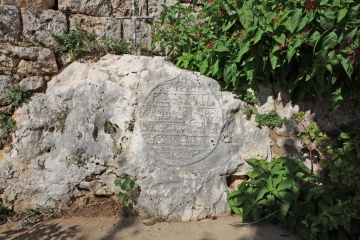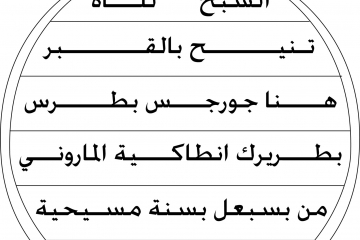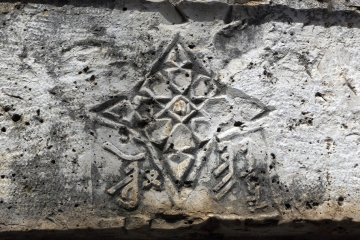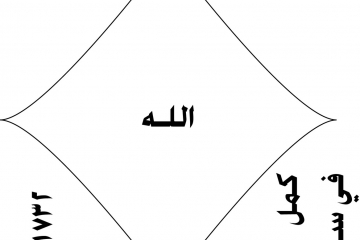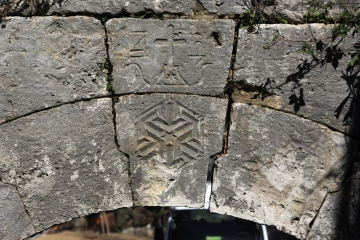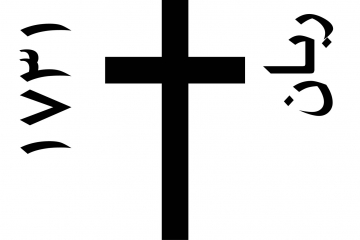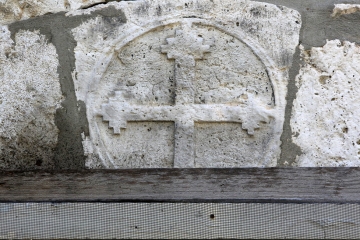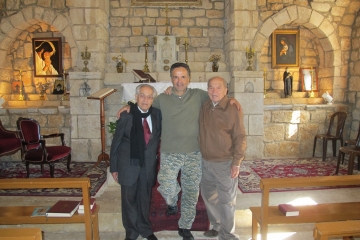دير مار شلّيطا مقبس – غوسطا
يُعتبر دير مار شلّيطا مقبس في بلدة غوسطا الأقدم في منطقة كسروان، إذ يذكر المؤرخ والباحث الأب بولس مسعد إن بناءه تمَّ في العام 1192م على يد "الكواليير باخوس" (Chevalier Bachus) وكيل ملك فرنسا فيليب أوغست (Le Roi Philippe Auguste) الذي قاد إحدى الحملات الصليبية.
وكلمة "غوسطا" تَعَدَدَت الروايات بشأنها. فمِنها مَن يقول إنه تحريف لإسم "أوغوستا" (Augusta) ومعناه الكبر والعظمة، ومِنها أن هذه المنطقة حَمَلَت إسم إبنة اغوسطوس قيصر التي كانت تتخذ من قلعة غوسطا مقراً لها. كما تُشير بعض المراجع القديمة الى أن الإسم مأخوذ من الملك فيليب أوغست أحد قادة الحملة الصليبية الثالثة في أواخر القرن الثاني عشر، والذي أقام أحد وكلائه "الكواليير" باخوس، المذكور أعلاه، فيها، فقام هذا الأخير بِتَسميتها على إسم هذا الملك تخليداً لذِكراه.
ويَذكُر الإستاذ أنطوان خويري في كتابه "تاريخ غوسطا" ما يلي: إن أقدم أديار غوسطا وكسروان عهداً هو دير مار شلّيطا مقبس، الذي تَتَعَدَّد روايات المؤرخين حول زمان وجوده وإنشائه وترميمه بعد تعرُّضه مراراً للدمار والخراب. ففي حين تُشير الآثار التاريخية الى أن هذا الدير هو في الأصل هيكل فينيقيّ، ما لَبِثَ إن تهدَّم بِفِعل مرور الزمن، فجاءت الأميرة جوليا أوغسْطا وأمرت بترميمه، وكان ذلك في العهد الرومانيّ، تأتي المدوَّنات لتقول إن الصليبيين وصلوا الى غوسطا ووجدوا خرائب كنيسة وغُرفاً قديمة العهد، فأمر احد قوّادهم الكواليير باخوس بتشييد معبد وبناء جديد وسكن فيه.
ولكنَّ هذا المَعبَد ومُلحقاته هُدمَت مع الحَملات المَملوكية في العام 1305، وبَقِيَت أطلالاً حتى العام 1615 حين إشترى الأرض هناك الخوري يوسف محاسب مع الأبنية المتداعية، يَشهَد على ذلك صَك شراء أرض الدير في العام المذكور.. الذي يقول الخوري إبراهيم حرفوش إنه عثرعليه بين الصُكوك العائدة لهذا الدير، وذلك من ضِمن مُستندات عائلة محاسب التي كان يَحتَفِظ بها الدكتور جدعون محاسب، الذي كان رئيساً للجنة وقف الدير من العام 1969 الى العام 2009.
والبطريرك إسطفان الدويهي، من جهته، يذكُر في كتابه "تاريخ الأزمنة" أن الشاري القَس يوسف محاسب طلب من إبنه القَس حنا إعادة بناء وتجديد الدير، وأكمل عماره سنة 1628، مُشيراً الى أنه "الأول في الديورة الذي صار في بلاد كسروان، وكان بُنيانه بِمُساعدة القُرى التي في جيرته". ولا يَختلِف الدويهي عن الآخرين بالنسبة الى أقدمية هذا الدير... ويذكُر إن من دير مار شلّيطا مقبس بدأت السيرة النسكية في كسروان.
ويُستنتَج من كِتابات مَن ذَكرنا، ومِمّا قاله الدويهي ومن صَك الشراء، إن أطلال الدير كانت كِنايةً عن كنيسة ومَعبد قديمَي العهد دون معرفة بانيهما، غير إن المؤكد إن تاريخ بِنائهما يعود الى ما قبل الحَملات المَملوكية على كسروان التي جَرَت في العام 1305، بِحيثُ هُجِّرت المَنطقة حوالي قَرنين ونِصف من الزمن.
أمّا الشهادة الأوثق حول تاريخ بناء هذا الدير فهي الكتابة الماثلة على عَتَبة مَدخل كنيسته، والتي تشهد بأن بناءه تمّ في العام 1628، وهي بالنص التالي:
" بإسم الآب والإبن والروح القدس إله واحد، كَمِلَ عَمار هذا الدير المُبارك مار شلّيطا في أيام سيّدنا البطريرك حنّا الأنطاكي في تاريخ سنة الف وست ماية وثمانية وعشرين مسيحية بيد المعلّم نقولا الشامي، وكان المُعتني الخوري المحاسب والخوري عطيَّا والخوري فرح والقرايا القريبة غسطا ودرعون وبطحا وعجلتون وعشقوت".
والجدير بالذكر إن هذه الكتابة مُدوَّنة بالكرشوني، أي إنها باللغة العربية، ولكن بحروف الأجدية السِريانية، وهي أول مرة تُنقش فيها لوحة تاريخية باللغة العربية وبحروف سريانية.
والبطريرك حنّا الأنطاكي المُشار إليه في هذه الكتابة هو يوحنّا مخلوف الإهدني (1608-1633) الذي حَصَل بناء هذا الدير في أيام بطريركيته. وهذا البطريرك إنتُخب ودُفن في قنّوبين، فتكون علاقته بدير مار شلّيطا مقبس مُقتصرة على إن بناءه تمَّ في عهده.
ويُذكر أن إعادة بناء هذا الدير تَمَّت بِتَغطية من إبن غبروش، من قرية مِعراب المُجاورة، الذي كان كاخيَّة الأمير إبن سَيفا التُركماني والي طرابلس، شَرط أن يتمَّ البناء ليلاً حتى لا يعرِف إبن سَيفا به، وأن يكون مَذبَح الكنيسة بإتجاه "القبلة" (الجنوب) كما كانت الحال في بناء الجوامع عند المسلمين. فَجَمَع الخوري حنا محاسب أهالي كلّ ٍ من غوسطا ودَرعون وبَطحا وعجَلتون وعَشقوت وأطلَعهم على هَدَفه، فكان له منهم ما أراد، وهذا دليل على تَضامن أبناء القرى قديماً في لبنان مع بعضهم البعض في سبيل إنجاز أعمال الخير وكانوا يُسمّونها "عونة".
ولما إكتشف إبن سَيفا بناء الدير أمسك القَس حنا وسجنه، فتَوَسّط إبن غبروش لإخراجه... وقد طلب القَس حنا من إبن اخيه القَس سركيس محاسب (الذي أصبح برديوطاً على يد البطرك الدويهي في ما بعد) أن يوافيه الى دير مار شليطا حيث سَلَّمَه الرئاسة سنة 1635، وقد توفي القَس حنا باني الدير بعد خمس سنوات في سنة 1640.
الا أن كنيسة الدير تَداعى سَقفِها في العام 1672، فرمَّمها الخوري سركيس بمساعدة البطريرك إسطفان الدويهي. وتُشير اللوحة الماثلة على جدار الكنيسة الى هذا الترميم باللغة السريانية وهذه ترجمتها: " بإسم الله، سنة 1672 ربّانية تجدَّد هذا الهيكل المُقدَّس في أيام سيّدنا البطرك إسطفان الانطاكي والشيخ أبو نوفل وأولاده المُكرَّمين، وبعناية إبن المحاسب الخوري سركيس، وكان البنّا القَس جرجس".
هذا الدير، وقد بُني من جانب أبناء عائلة محاسب وشُريت الأرض التي قام عليها بمالهم، كان من الطبيعي أن يصبح مُلكاً أو وقفاً لهم، وتولّت عليه مُنذَ تأسيسه سنة 1628 لغاية سنة 1786، أي طِوال 158 سنة. ولكنَّهم، بعد هذه المُدّة الطويلة، حَصَل حادث مؤسف أدّى الى إنتزاع ولايته منهم وجعلها بيد السُلطة الكنسية. إلاّ أنهم عادوا وإستلموا إدارة الدير من سنة 1845 لغاية سنة 1964.
وقد روَت المؤرخة الدكتورة سابين محاسب صليبا في كتابها "الأديار المارونية المزدوجة في لبنان" الحادث الذي أدّى الى إبعاد العائلة عن الإمسّاك بالدير، ومُلخَّصه أن راهباً شاباً من العائلة قَتَل إبن عمّه الخوري أنطون محاسب، الذي كان مُترئساً على الدير بِسَبب مُنازعات عائلية قديمة أو تنافس على رئاسة الدير، ولكنها تُضيف إن الامر يوحي بأن الفاعل كان مُصاباً بلوثة عقلية، لأن طريقة القتل أثناء نوم المغدور، وبالفرّاعة، لا تَدلُّ على إن القاتل يتصَرَّف كما يتصَرَّف المُجرِم، وهو قد عَقبَ فعلته بإنتحاره عن طريق رمي نفسه في بئر الدير، المَعروف بالمَصنَع، مِمّا ينفي كونه كان يطمع بالترؤس على الدير بدلاً من القتيل. وذلك ما دعا الى إنتزاع إدارته من أيدي أبناء العائلة، وتحويله ديراً عامّاً تُشرف عليه المرجعية الروحية للطائفة، فأصبح بالمُستطاع جَعلِه، في بعض الأوقات، مَقرّاً لعدد من البطاركة. وقد شُرِّع كمقرّ ٍبطريركيّ بِموجب قرار صَدَر عن مَجمَع عَقَدَه البطريرك يوسف التيَّان في دير سيّدة قَنّوبين، علماً بأن هذا القرار لم يُنفَّذ رسمياً بِسَبَب إستقالة البطريرك التيَّان، ولكنَّ بعض البطاركة كان قد سَكن هذا الدير، وسَنَذكُرهم في ما يلي مع إيراد نبذةٍ عنهم.
البطارِكة الخَمسة الذين سكنوا الدير
البطريرك جرجس البِسبعلي (1657-1670) والبطريرك مار إسطفان الدويهي (1670-1704) ويعقوب إبن الخوري يوحنا عواد (1705-1733) والبطريرك يوسف التيَّان (1796-1809) والبطريرك يوحنا الحلو (1809-1823)، أمّا البطريرك يوسف إسطفان (1766-1793) فقد تمَّ إنتخابه في هذا الدير..
أوّل من سَكَن الدير هوالبطريرك جرجس البِسبعلي (1657-1670)، وهو جرجس إبن الحاج رزق الله من قرية بِسبعل في منطقة الزاوية، إنتُخب بطريركاً في قنّوبين في أول كانون الثاني سنة 1657، ورَفَع رسالةً الى الكردينال رئيس المجمع المُقدَّس لنشر الإيمان يطلب منه تثبيت إيمانه، فمُنح التثبيت والدِرع المُقدَّس في 26 ايار من ذلك العام.. بِشَرط أن يتلو صورَة الإعتراف بالإيمان الكاثوليكي أمام مطران إهدن ومطران حوقا.
ولكنَّ المراجِع تَختَلِف حول ما إذا كان قد قضى بعض سِني بطريركيته في دير مار شلّيطا مقبس أم أنه فقط جاءه في آخر عمره ليموت ويُدفن فيه. فبينما نَقَع على نَصٍ يقول أنه لا يُعرَف ما إذا كان قد إستقرَّ في هذا الدير.. نقع على نَصٍ آخر يَذكُر أنه سَكن في قنوبين وفي دير مار شلّيطا مقبس.. مُتنقّلاً في إقامته بينهما. أمّا الدكتور جورج هارون فيقول إن إقامته كانت في دير قنوبين حيث زاره فيه الشيفاليه دارفيو. ويَصِف الدكتور هارون غرفة البطريرك في الدير ذاكراً أن مساحتها ثمانية أقدام عرضاً واثنا عشر قدماً طولاً، وكان يَرقُد فيها على ألواحٍ خشبية موضوعة أرضاً.
توفي هذا البطريرك في 12 نيسان سنة 1670، يوم سَبت الحواريّين، في دير مار شلّيطا مقبس، ودُفن في مدفنٍ خاص خارج الكنيسة الى جهة الغرب، إذ خاف سُكان الدير من دَفنَه داخل كنيستهم بِسَبَب المرض الوبيل الذي أصابه والذي يُسمّيه بعضهم الجِذام وبعضهم الطاعون، والدكتور هارون يقول، خلافاً لذلك، إنه مات بداء السِلّ.
وهذا القبر لا يزال مَحفوظاً وباقياً الى يومنا، وقد نُقشت على الصخر، تحت علامة الصليب، كتابة بالسريانية هذه ترجمتها :
"السَّبح لله، تنيَّح بالقبر هنا جورجس بطرس بطريرك إنطاقية الماروني، من بِسبعل، بسنة مسيحية 1670، 12 نيسان".
والبطريرك الثاني الذي مرَّ في هذا الدير كان البطريرك مار إسطفان الدويهي (1670-1704)، وقد جاء على أثر وفاة البطريرك البَسبعلي، وسَبق أن تكلَّمنا عنه مُفصَّلاً في سِياق كلامنا عن بطاركة قنّوبين.
وتضيف المؤرخة الدكتورة سابين محاسب صليبا، في كتابها "الأديار المارونية المزدوجة في لبنان"، الى أسباب إنتقال بعض البطاركة الموارنة من الشمال الى دير مار شلّيطا مقبس إن الثلاثة الأولين منهم، وهم جرجس البِسبعلي وإسطفان الدويهي ويعقوب عواد، فعلوا ذلك لوجود، قرب هذا الدير، مقام للبطاركة يُدعى حارة مار بطرس، وكذلك إنسياقاً مع حركة النزوح الماروني نحو المناطق الوسطى من الجبل بسبب الوضع غير المُلائم للعيش في المناطق الشمالية ومِنها المقرّ البطريركي بدير سيّدة قَنّوبين حيث الأمان غير متوفر دائماً، ونظراً للدَور المُتزايد لمشايخ آل الخازن، ولأهمية منطقة كسروان، هذا المَوئل الجديد للطائفة المارونية الذي غدا نقطة الثقل في تواجدها.
بَعدَ البطريرك إسطفان الدويهي جاء الى السدَّة البطريركية جبرائيل البلوزاني نزيل دير قنّوبين الذي تَكلَّمنا عنه أثناء حديثنا عن هذا الدير.
وبعد وفاة البطريرك جبرائيل التأم، في اليوم التاسع لرحيله، مجمع الأساقفة والاكليروس في قنّوبين وإنتخب، خلفاً له، المطران يعقوب إبن الخوري يوحنا عواد ( 1705-1733)، من حصرون، وهو تلميذ المدرسة المارونية في روما، وكان قبل إنتخابه بطريركاً مطراناً على طرابلس. وقد أُرسلت رسالة الإنتخاب الى المَجمَع المقدَّس لنشر الإيمان مع طلب التثبيت، فثبَّت البابا كليمَنت الحادي عشر (1700-1721) هذا الإنتخاب برسالة مؤرخة في 21 شباط 1706، ومنح البطريرك الدِرع المُقدَّس على يد وكيله الأب فرديناند الكرملي برسالة مؤرخة في 21 آذار 1706، أي بعد شهر تماماً من رسالة التثبيت.
إلا أن بعض الأساقفة أقدَمَ على عَقدِ مَجمَع قَضى بِتَعرية هذا البطريرك من الحِلَل الحَبرية وعَزله، وننقل عن الخوري منصور الحتّوني في "المقاطعة الكسروانية":
"لكنَّ عدوَّ الخير، خَذله الله، حَرَّك قلوباً بالحَسد، فراح بَعضُهم يتهمون زوراً البطريرك المَبرور يعقوب عواد بما هو براء منه، حتى خُيِّل الى بعض الأتقياء إن التهم صحيحة، فإجتمع مطارين الطائفة سنة 1710 في دير مار سركيس وباخوس - ريفون وأنزلوه عن البطريركية ظُلماً وعدواناً، وأقاموا بدلاً منه المطران يوسف مبارك الريفوني، وعرضوا للسِدة الرسولية في رومة الأسباب التي حَمَلتهم على تنزيله. فأرسل المَجمَع المُقدس، في 11 كانون الثاني 1711، البادري لورنسيوس الفرنسيسكاني من رهبان القدس، قاصداً خاصاً لفَحِص هذه الدعوى المُهمة. فأقام القاصد في دير حريصا وباشر مهمته. وغِب الفَحص والتدقيق، وإستجواب الشهود الذين إعتُمد على أقوالهم لعزل البطريرك، سَجَّل البادري لورنسيوس كل شيء بصراحة وبَعَث به الى المَجمَع المُقدس، فَوكَّل البابا كليمَنت الحادي عشر (1700-1721) الى كرادلة مَجمَع إنتشار الإيمان المُقدس درس تقرير القاصد الخاص".
وبعد ذلك التأم المَجمَع المُقدَّس في 20 آذار من العام 1713 وفَحَص فَحصاً مُدقَّقاً عن دعوى البطريرك يعقوب.. خاتماً بتبرئته من التُّهم التي وُجِّهت إليه. وفي 30 حزيران من ذلك العام أرسل البابا كليمَنت الحادي عشر(1700-1721) رسالة وجَّهها الى كل الطائفة المارونية يُعلِن فيها باطلاً تنزيل البطريرك يعقوب عن كرسيّه ويعيده الى مركزه، مُحرّضاً أبناء الطائفة جميعاً على الإمتثال لأوامر الكرسيّ الرسولي وتأدية الطاعة والخضوع للبطريرك.
ويقول الخوري يوسف مارون الإطرابلسي في "أصل الموارنة" : "إن أغلب ما حَدَث لهذا البطريرك كان مُسبَّباً من بعض أقاربه، وإن إقاربه كانوا عقاربه، فَتمَّ فيه قول الإنجيل الطاهر: إن أعداء الإنسان أهل بيته". ومِمّا يُروى إنه لما ظهرت براءة هذا البطريرك ورَجِع الى كرسيِّه لم يُظهِر لأحدٍ مِنهم أي إشارة مَلام أو عِتاب.. بل كُل المَحبة. وقد قام هذا البطريرك في أثناء ولايته بأعمالٍ باهرة، منها المعونة الكبيرة التي أسداها للعلاَّمة يوسف سمعان السمعاني من أجل العثور على الكتب الشرقية والمخطوطات النادرة الموجودة في المكتبة الفاتيكانية.
توفي البطريرك يعقوب عواد في 12 شباط سنة 1733 في دير مار شلّيطا مقبس في غوسطا ودُفن فيه، كما هو مذكور على منحوتة كائنة على احد جدران الكنيسة :
"إنتقل بالوفاة لرحمة مولاه البطرك يعقوب الأنطاكي الحصروني في ثاني عشر من شباط سنة 1733 مسيحية، واستمر بالرياسة سبعة وعشرين سنة وثلاثة أشهر وجمعة، ودُفن في دير مار شليطا كسروان بوجود مطارين وكهنة ومُرسلين والمشايخ الخوازنة وجمع غفير.. في غاية الإكرام والشان، تغمَّده الله برضوان النعمة، أرَّخ لغايته أب الرحمة، كتب قيس الخازن".
ثم، بعد هذا البطريرك، تَعاقَب ثلاثة بطاركة لا علاقة لهم بدير مار شلّيطا وهم يوسف ضرغام الخازن وسمعان عواد وطوبيا الخازن، الى أن إنتُخب بعدهم البطريرك يوسف إسطفان (1766-1793) في هذا الدير كما يقول الدكتور جورج هارون، بينما سِلسِلة العنَيسي تقول إنه لا يُعرَف في أيّ ديرٍ تمَّ إنتخابه، ولكنها تُضيف إنه كان مُقيماً في دير مار يوسف الحُصن في غوسطا وإنه توفيّ ودُفن فيه، لذلك سوف نتكلم عنه عندما نتناول هذا الدير.
وكان خليفته البطريرك ميخائيل فاضل (1793-1795) الذي سَبَق الكلام عنه في أثناء الحديث عن دير مار يوحنّا حراش. وبوفاته إنتقلت السدَّة البطريركية الى المطران فيلبُّس الجميّل الذي سكن دير سيّدة قَنّوبين ودير سيّدة بكركي، والذي سبق إن تكلمَّنا عنه مفصَّلاً في سياق كلامنا عن بطاركة قنّوبين.
وهنا جاء على رأس الطائفة البطريرك يوسف التيَّان من بيروت (1796-1809). وعام 1809 لا يشير الى سنة وفاته بل الى سنة إستقالته من منصبه البطريركيّ كما سَنُفصِّل ذلك لاحقاً.
إنتُخب في دير بكركي في 28 نيسان سنة 1796 وهو يَبلُغ من العمر 36 عاماً، أي إنه كان يوم إنتخابه من أصغر بطاركة الطائفة. وقد نال دِرعَ التثبيت من البابا بيوس السادس (1775 - 1799) في 24 تموز سنة 1798. وقد خَطَب البابا في إحتفال تثبيته قائلاً: "هو شابّ في عُمره، وُلد في 5 آذار سنة 1760، ولكنه شيخٌ في فضائِله".. كما ذَكَرت "سِلسِلة العنَيسي" لدى إيرادها نبذة عنه.
عن نشأته وسيرته نعود الى الباحث المحامي الدكتور هيام ملاّط الذي تبيَّن له الآتي كما نقله عنه الدكتور جورج هارون في كتابه: "وُلد البطريرك يوسف التيَّان تحت إسم مفوَّض إبن سلّوم التيَّان، من بيروت، عام 1760، وكان وحيداً لوالديه مع شقيقته. فتلقَّن مبادىء الدروس الأولية في مدرسة بيروتية وكان الأول في صفِّه، ثم أرسله البطريرك يوسف إسطفان تلميذاً الى المعهد الماروني الروماني في روما عام 1773 كما يُفيد السِجلّ البطريركيّ، فأتقن العربية والسِريانية واللاتينية والإيطالية والفرنسية وحاز المَلفنَة في العلوم، ثم دَخَل سلك الكهنوت في روما سنة 1782 ودُعي بإسم يوسف.
وفي عُمر السادسة والعشرين رُقّي الخوري يوسف التيَّان الى الدرجة الأسقفية على يد البطريرك يوسف إسطفان في كنيسة دير مار يوسف الحصن في خراج بلدة غوسطا.
ويقول الأب لويس صفير في كتابه "البطريرك يوسف التيَّان" إن البطريرك يوسف إسطفان جعله أسقفاً على أبرشية دمشق، وفي الوقت نَفسَه وكيلاً بطريركياً بالنسبة الى الأمور الروحية. ويتابع قائلاً إنه، كمطران، نمَّ عن إستقامة وضمير حيّ وحَذقٍ وبراعة. وظلَّ في خدمة البطاركة يوسف إسطفان (1766-1793) وميخائيل فاضل (1793-1795) وفيلبُّس الجميّل (1795-1796) ومُدبّراً لشؤون الطائفة بِحِكمة ودراية الى أن توفّي البطريرك فيلبّس الجميّل، فالتأم مجمع الأساقفة في دير سيّدة بكركي وإصطفاه بطريركاً بتاريخ 28 نيسان سنة 1796، فأوفد القَس لويس بليبل، سنة 1798، الى روما ليحصل له على دِرع التثبيت من البابا بيوس السادس (١٧٧٥-١٧٩٩)، فناله بتاريخ 24 تموز سنة 1798.
وبدورهم أرسل الأساقفة، يوم 30 نيسان 1796، رسائل الى البابا والى المَجمَع المُقدَّس لنشِر الإيمان تِشهُد بأنهم إنتخبوا هذا البطريرك بملء رِضاهم وقبولهم، وبكامل حُرّيتهم ودون أيّ ضغطٍ عليهم، نظراً لخُلقه الحَسن، وتدبيره الحكيم، وطيبته وثقافته العالية، وعلى الأخص نظراً لإندفاعه في العمل من أجل خلاص النفوس.
وكان له شهادة أيضاً من المؤرخ المطران بطرس ديب الذي أشاد بتَضَلُّعه من عِلم اللاهوت وبإطّلاعه الواسع على الفِكر عامَّةً وثقافته النادرة. ولعل أثمن شهادة أُعطيت فيه هي شهادة البابا بيوس السادس (١٧٧٥-١٧٩٩) التي ذكرناها من إنه شابّ في عمره ولكنه شيخٌ في فضائله. وهيامه بالعلوم، وخاصةً العلوم الروحية والدينية، دَفَعه الى بَذل كل عنايته من أجل إعادة مدرسة عين ورقة التي كان أستاذ اللاهوت فيها. ولكنَّ فَضلَه الأكبر كان على دير مار شلّيطا مقبس، إذ عقد، بتاريخ 4 ايار 1808، مَجمَعاً في دير سيّدة قَنّوبين تقرَّر فيه تحديد دير مقبس في غوسطا مقرّاً بطريركياً.
وكان المَجمَع اللبناني الذي إنعقد عام 1736 قد قرَّر إن المقرَّ البطريركي يجب أن يكون ثابتاً، (وكان دير قنّوبين هو المقرّ البطريركي في ذلك الوقت)، ولا يمكن تغييره إلاّ بموجب قرار صادِر عن مَجمَع أساقفة ولسبب مشروع وقاهر جداً ومع موافقة الكرسيّ الرسولي. فجاء المجمع الأول الذي إنعقد في بكركي سنة 1790 يحدد، في دورته التاسعة، دير سيّدة بكركي مقرّاً بطريركياً، وهو ما صادق عليه مرسوم صَدَر عن المَجمَع المُقدَّس لنشر الإيمان بتاريخ 10 حزيران 1793.
ولكنَّ النقاط الهامَّة التي إستعرضها مَجمَع دير سيّدة قَنّوبين بالنسبة لدير مار شلّيطا كانت التالية:
* إن دير بكركي لا يُلائم إقامة البطاركة فيه للأسباب الآتية: إنه يقع على حافَّة الطريق، ويُحيطه مناخ سيّء، ولذلك فإن البطاركة الذين سبقوا البطريرك التيَّان لم يقيموا فيه.
* أما دير قنّوبين فلم يعد مُناسباً لإقامة البطاركة بسبب بُعده.
* دير مقبس مُناسب لهذه الإقامة لأنه بعيد عن الطريق، ويقع وسط مناخ جيّد، وبناؤه كافٍ وملائم لمن يأتون لمعالجة قضاياهم.
* جاء في أحد المُستندات إن البطريرك (التيَّان) وافق على إختيار الأساقفة هذا المقر ضمن الشروط الآتية:
+ نقل الراهبات المُتوحدات في دير مار شلّيطا الى أديرة اخرى.
+ إن ممتلكات الدير المنقولة وغير المنقولة تَصبَح منذ إعتماده كرسيّاً بطريركياً مُلكاً لهذا الكرسيّ.
+ هذه المُمتلكات لا تُباع ولا تُرهَن ولا تُنقل ملكيتها بأية صورة من الصور.. تحت طائلة العقوبات التي سوف يُنَصُّ عليها.
+ يقيم فيه البطريرك أطول مدةٍ من السنة، ولا يتغيَّب عنه إلاّ مؤقتاً ولإنجاز بعض المسائل.
+ إن اعضاء عائلة محاسب التي أدَّت خدمات لهذا الدير يحظون بمعاملة خاصة: فالفقراء منهم، وكبار السِنّ غير القادرين على تحصيل عيشهم، إما أن يجري ايواؤهم في دير مقبس.. أو يقدّم لهم البطريرك ضروريات العَيش.
+ بما إن واردات الدير تربو على نفقاته الضرورية، فإن العدالة والإنصاف يوجبان إقتطاع قسم منها لإنفاقه في ما يعود الى الصالح المشترك للطائفة، وذلك بايواء ستة أولاد موارنة وفقراء فيه يختارهم البطريرك، وولدٍ من آل محاسب إذا كان موجوداً. ويؤمَّن لهؤلاء الأولاد التعليم والعلاج والإعالة بإستثناء الولد الذي من عائلة محاسب الذي يعامَل كأولاد عائلة إسطفان في عين ورقة.
+ قبول جميع التدابير التي يتخذها البطريرك ومَجمَع الأساقفة بثلثَي الأصوات في ما يختص بنقل الراهبات المُتوحدات.. حتى ولو أُلغي احد الأديرة.
+ إذا تخلّى أحد البطاركة عن تحقيق الشروط المذكورة اعلاه، فإن الحق على هذا الدير يعود الى الأساقفة والى مَن كانوا اصحاب حق عليه، والكرسيّ البطريركي يُعتبر في هذه الحالة ديراً كسائر الأديار.
وفي 12 آب سنة 1816 صَدَر مرسوم عن المَجمَع المُقدَّس لنَشِر الإيمان، صَدَّقه البابا بيوس السابع (1800-1823) برسالة مؤرخة في أول تشرين الثاني 1816، يُعلن الموافقة على الكرسيّ البطريركيّ الجديد في مقبس لأنه يستوفي الشروط المُعتادة، أي الدافع القاهر والمُهمّ الذي أخذ به مَجمَع للأساقفة، إنما ليس في دير مُختلط يضمُّ رهباناً وراهبات، كما يَحظى بموافقة الكرسيّ الرسوليّ عليه.
بعدها كان قرار قد صَدَر عن مَجمَع 1818 أعاد لعائلة محاسب الحق بتولّي إدارة الدير، وحَفَظ لها وحدها، على الأخص، الحق بتقديم الأشخاص المؤهلين لإدارة الدير. ولمّا كان من الضروريّ أن يكون الشخص المُعيَّن لهذا المركز راهباً، لأن الامر يتعلق بدير، فهو يُمكِنه أن يكون أيضاً من العائلة المؤسِّسة له، على أن يَحظى تعيينه بموافقة مطران الأبرشية لأنه هو صاحب الحق بتكريس تولّيه لهذه الوظيفة. لذلك فبعد زمنٍ طويل لم يُقبِل خلاله أحد من آل محاسب على الحياة الرهبانية، وخصوصاً للترهب في دير مار شلّيطا، دخل نجل الياس جدعون محاسب، المدعو عمانوئيل (المُتحدّر من فرع مؤسس الدير في العائلة)، الرهبانية اللبنانية البلدية وسِيمَ كاهناً في العام 1841، فعيَّنه المطران أنطون الخازن، يوم 25 كانون الأول 1845، رئيساً على دير مار شلّيطا، وهكذا، منذ تَرَؤس الأب عمانوئيل على الدير في نهاية العام 1845، عادت عائلة محاسب تتولّى عملياً بنفسها "شؤون الدير". ولكنَّ هذه الاستعادة لولايته لم تَكُن مُمكِنة لولا المَساعي المُتعددة التي قام بها فرنسيس مرعي محاسب، إبن عم الاب عمانوئيل والمُتَحدر من فرع شقيق المُؤسِّس، لدى السلطات الرومانية والمارونية.
بالعودة الى البطريرك التيَّان فقد جابهته، خلال مدة ولايته البطريركية، قضايا سِياسية كان عليه، بموجب كونه راعياً لأبناء طائفته، أن يَتَصدّى لها بما إتصف به من حرص على أن يأخذ الحق والعدل مجراهُما في مُعاملة الحُكام للشعب، كما أن يقوم الحاكم بتعهداته التي إلتزم بها وأقسم على ذلك. ولما كان الأمير بشير الشهابي الكبير، بعد خصومة مع أبناء عمه الامير يوسف شهاب الذين كان مُدبّرهم جرجس باز، من دير القمر، قد جَرَت مُصالحة بينه وبينهم على أساس أن يحكم الأمير بشير المُقاطعة الجنوبية من لبنان مقيماً في دير القمر، ويكون مدبّره جرجس باز، ويَحكُم الامراء أبناء الامير يوسف المُقاطعة الشمالية من البلاد مقيمين في جبيل، ويكون مُدبّرهم عبد الأحد باز اخو جرجس. فجاء جرجس باز الى دير القمر، وصالحه الأمير بشير وعيَّنه في ديوانه. ولكن لزيادة إطمئنانه إليه طلب منه أن يَحلُف يميناً على القربان المقدَّس في كنيسة سيّدة التلة أمام البطريرك يوسف التيَّان بأن يُخلص له قلباً وقالباً، ويَمتنِع باطناً وظاهراً عن أن يُلحق به أيَّ أذىً او غدر، فقبل جرجس بذلك على أن يُقسم الأمير مثل هذا القَسَم بالمقابل. وبعد أن تراضيا على هذا الأمر إستُدعي البطريرك التيَّان سرّاً الى دير القمر، وسار الجميع الى الكنيسة ليلاً تحت طيّ الكِتمان، فدخلاها ومع كل فريق أنصاره، ثم أُقفلت أبوابها ونوافذها، وإتشح البطريرك بالملابس الحبرية وأقام قداساً صَمَد في نهايته القربان على المذبح بين أنوار الشموع، وتقدَّم الأمير وجرجس باز فحلفا اليمين أمامه بأن يُخلص كل منهما للآخر إخلاصاُ لا غشَّ فيه، ثم إنصرفا مُطمئنَّي البال بعد أن أرفقا البطريرك بحرس يوصله الى كرسيّه دون طنطنة، شاكرَين إياه على ما كابد في سبيلهما من تَعب.
هذه المَعلومات إستقيناها من كتاب المؤرخ لحد خاطر "بين أمير وراهب"، ولكنَّ الأمير بشيراً حَنَث بيمينه وقتل جرجس باز وأخاه على الوجه المَعروف، مِمّا أثار غضب البطريرك وإستياءه الشديد. ثم حدث ما زاد في حِدَّة غَضَبه عندما رفع الأمير بشير الضريبة المُسمّاة "قرش الميرة" الى ستة قروش، فَتذمَّر الشعب من فداحة الضَرائب، وراح البطريرك يُناضل عن حقوق الشَعب المَظلوم، وَوَصَل به الأمر الى تهديد الأمير بالحُرم إن لم يرجع عن عزمه على رفع قرش الميرة الى سِتة قروش. فأخذ الأمير يتآمر عليه مع بعض موفدي الكرسيّ الرسولي ويوصل عنه الأخبار المُزيفة بواسطتِهم الى البابا. ولم يَكن البطريرك من جهته مُتمسكاً بالمنصب، بل كان يؤثر حياة الزهد والنسك على المناصب الرفيعة. وجاءت معاكسة بعض أساقفته لأعماله ومقاصده الخيرية والإنسانية، وإستمالتهم إليهم بعض أصحاب الأمر، لتزيده تفضيلاً للإعتزال، فقدَّم إستقالته في العام 1809 وإلتزم الحياة النسكية أولاً في محبسة مار افرام بقرية درعون التي لا تبعد كثيراً عن دير مار شليطا مقبس ثم في دير قنوبين.
وقد وَرَد في الإلتماس الذي قدَّمه الى الكردينال رئيس المجمع المقدًّس لنشر الإايمان لإعفائه من مهامّه البطريركية ما يشير الى الاسباب السياسية والخصومات الشخصية التي حَدَت به الى الإستقالة إذ قال:
"لما كنتُ تَحَقَقتُ أن صِرتُ غير قادر أن أفيد طائفتي في مقامي البطريركي، بل أجلب لها ضرراً في الروحيات والزمنيات، عَزمت على الإستعفاء من البطريركية وإعتزال الناس، مُختاراً العيشة الإنفرادية للإشتغال بخلاص نفسي. إن مُضادَة حُكامنا لي العنيفة جداً، والشكوك الفظيعة الحاصِلة في الطائفة، هي الداعي الأول لإستعفائي، وما يَنجُم عن تلك الحال من الشُكوك والأضرار تعرفه نيافتك".
وافت المنيَّة البطريرك يوسف التيَّان في دير سيّدة قَنّوبين في العشرين من شباط سنة 1820، فدُفن في مدفن البطاركة أسلافه في مغارة القديسة مارينا.. الى إن نُقل جثمانه في ما بعد الى داخل الدير على الوجه المبيَّن في الكلام عن دير قنوبين.
وخَلَف التيَّان على السدَّة البطريركية البطريرك يوحنا الحلو (1809-1823)، من بلدة غوسطا، الذي تكلَّمنا عنه في أثناء حديثنا عن بطاركة قنّوبين. فإستمرَّ على السكن في دير مار شلّيطا مقبس خلال السنوات الأولى من حبريته قبل إنتقاله الى دير سيّدة قَنّوبين، خاصةً وإنه كان في زمن إسقفيته معاوناً للبطريرك يوسف التيَّان (1796-1809) وقيّماً على هذا الدير.. كما جاء في كتاب المؤرخة الدكتورة سابين محاسب صليبا.
Saint Shallita Moqbes Monastery – Ghosta
The Monastery of Saint Shallita Moqbes in the town of Ghosta is considered the oldest in the Keserwan region. The historian and researcher Father Paul Massad mentions that it was built in the year 1192 AD by Chevalier Bachus, a knight at the service of the King of France Philippe Auguste, who led one of the Crusades.
There are many stories behind the word "Ghosta”. Some say that it is a distortion of the name "Augusta", which means greatness, and some say that this region bore the name of the daughter of Augustus Caesar, who lived in the fortress of Ghosta. Some ancient references also indicate that the name refers to King Philippe Auguste, one of the leaders of the Third Crusade in the late twelfth century, who gave permission to one of his knights, Bacchus, to live there, and the latter named it in honor of this king.
Professor Antoine Khoueiri mentions in his book “The History of Ghosta” the following: The most ancient monasteries of Ghosta and Kesrouan are the monastery of Mar Shallita Moqbes, of which historians have repeatedly documented the existence, establishment, and restoration after it was repetitively subjected to destruction and devastation. While historical monuments indicate that this monastery was originally a Phoenician temple that was destroyed by the passage of time, Princess Julia Augusta commissioned its restoration in the Roman era. The records indicate that the Crusaders arrived in Ghosta and found the ruins of a church and ancient rooms. One of their leaders, Bacchus, ordered the construction of a temple and a new building where he lived.
But this temple and its annexes were demolished during the Mamluk campaigns of 1305, and it remained in ruins until 1615, when a priest by the name of Youssef Mohaseb purchased the land on which the dilapidated edifices remain. This is attested by the deed of property of the monastery’s land issued in the aforementioned year, which priest Ibrahim Harfouche says was found among the deeds belonging to this monastery and the documents of the Mohaseb family that was kept by Dr. Gideon Mohaseb, who was the head of the Monastery Endowment Committee from 1969 to 2009.
For his part, Patriarch Estephan Al-Duwaihy mentions in his book “The History of Time” that the purchaser, Reverend Youssef Mohaseb, asked his son, Reverend Hanna, to rebuild and renovate the monastery, and he completed its building in 1628, noting that “it was the first monastery to be built in Keserwan, with the help of villagers from the neighborhood." Al-Duwaihy does not contradict others with regard to the antiquity of this monastery, as he mentions that the Mar Shallita Moqbes monastery is older than the Quzhaya monastery, and that it is there that ascetic life began in Keserwan.
It can be inferred from the writings of those we mentioned, what Al-Duwaihy said, and from the purchase deed, that the ruins of the monastery that of an ancient church and temple of which the builders could not be determined. However, certainly, the date of their construction dates back to before the Mamluk campaigns against Kesrouan that took place in 1305, when the area was abandoned for about two and a half centuries.
The most reliable testimony about the history of the construction of this monastery is the inscription on the threshold of the entrance to its church, which attests that its construction took place in 1628, and the text is as follows:
“In the name of the Father, the Son, and the Holy Spirit, one God, the construction of this blessed monastery of Mar Shallita was completed in the days of our patron Patriarch Hanna of Antioch in 1628, at the hands of Master Nicholas Shami, under the supervision of priests Mohasseb, Atya, Farah, and with the help of the inhabitant of the nearby villages of Ghosta, Daroun, Batha, Ajaltoun and Ashkout.
It is worth noting that this text was written in the Karshuni script, meaning in the Arabic language the Syriac alphabet, and it is the first time that a historical table was engraved in Arabic and Syriac letters.
The Patriarch Hanna of Antioch referred to in this text is Youhanna Makhlouf Al-Ehdani (1608-1633), who built this monastery during his tenure.
This patriarch was elected and buried in Qannoubine, so his relationship with the Mar Shallita Moqbes monastery is limited to the fact that it was built during his reign.
It is reported that the rebuilding of this monastery was covered by Ibn Ghabrush, from the neighboring village of Maarab, during the time of Prince Ibn Siva the Turkmen, under the condition that the construction takes place at night so that Ibn Siva would not be aware of it, and that the altar of the church be facing the “qiblah” (south), as was the case for mosques. So priest Hanna Mohasseb gathered the people of Ghosta, Daraun, Batha, Ajaltoun, and Achkout, and shared his ambition with them. They gave him what he wanted, and this is an indicator of the solidarity of the people of the ancient villages in Lebanon and their endeavor to accomplish charitable actions, which they used to call “aid.”
When Ibn Siva discovered the construction of the monastery, he arrested priest Hanna and imprisoned him, but Ibn Ghabrush interceded to liberate him. Father Hanna asked his nephew, the Reverend Sarkis Mohaseb (who became Bardiota under the reign of Patriarch Douaihy later) to take him to the monastery of Mar Shallita, where he handed over the presidency to him in 1635. Reverend Hanna died five years later in 1640.
However, the roof of the monastery’s church collapsed in1672, so Father Sarkis restored it with the help of Patriarch Estephan Douaihy. The plaque on the church wall refers to this restoration in the Syriac language, and this is its translation: “In the name of God, in the year 1672, this holy temple was renovated during the days of our master Patriarch Stephan al-Antaki and Sheikh Abu Nofal and his honored children, under the care of Father Sarkis Mohassed, and the builder Reverend Gerges.”
This monastery was built by the sons of the Mohasseb family, and the land on which it was built was bought with their money. It would have been natural for it to become their property, but, after it remained under their control for a long time, an unfortunate accident led to its transfer to the hands of the ecclesiastical authority.
Historian Dr. Sabine Mohaseb Saliba recounted in her book "Dual Maronite Monasteries in Lebanon" the incident that led the family to be deprived of the monastery, and its summary is that a young monk from the family killed his cousin, the priest Antoun Mohasseb, who was presiding over the monastery because of old family disputes or competition over the presidency of the monastery, but she adds that it is suggested that the perpetrator was mentally deranged because the method of killing, which occurred while the victim was sleeping, and with an ax, does not indicate normal criminal behavior. Moreover, he subsequently committed suicide by throwing himself into the monastery well, known as the factory, which invalidates the theory that he coveted the presidency of the monastery. This is what prompted the transfer of its management from the hands of the family and its transformation into a public monastery supervised by the spiritual authority of the sect. It was legislated as a patriarchal seat by a decision issued by a synod held by Patriarch Youssef al-Tyan in the monastery of Our Lady of Qannoubine, noting that this decision was not officially implemented due to the resignation of Patriarch al-Tyan. However, some patriarchs did reside in this monastery, and we will mention them in this chapter.
The five patriarchs who resided in the monastery
Patriarch Gerges al-Basbaali (1657-1670), Patriarch Mar Estephan Douaihy (1670-1704), Jacob the son of the priest Youhanna Awwad (1705-1733), Patriarch Youssef El-Tyan (1796-1809), Patriarch Youhanna El-Helou (1809-1823), and Patriarch Youssef Estephan (1766) -1793) who was elected in this monastery.
The first to inhabit the monastery was Patriarch Gerges Al-Basbaali (1657-1670). He is Gerges the son of Hajj Rizkallah from the village of Basbel in the Zawia region. He was elected Patriarch in Qannoubine on January 1, 1657, and sent a letter to the Cardinal, President of the Holy Synod to Spread the Faith asking him to confirm his faith. Confirmation and the Holy Shield were granted to him on May 26 of that year, on the condition that he recite the confession of the Catholic faith before the Metropolitan of Ehden and the Metropolitan of Hawqa.
However, the references diverge on whether he spent some years of his patriarchate in the monastery of Mar Shallita Moqbes, or whether he only came to it at the end of his life to die and be buried there. While we find a text that says that it is not known whether he settled in this monastery, we find another text that mentions that he lived in Qannoubine and in the monastery of Mar Shallita Moqbes, alternating between both residences. As for Dr. George Haroun, he says that he was staying in the Qannoubine Monastery, where Chevalier(knight) Darvio visited him. Dr. Haroun describes the patriarch's room in the monastery, stating that it was eight feet in width and twelve feet in length, and adds that he used to lie in it on wooden planks laid on the ground.
This patriarch died on April 12, 1670, on the Saturday of the disciples, in the monastery of Mar Shallita Moqbes, and was buried in a special cemetery outside the church to the west, as the residents of the monastery were afraid to bury him inside their church because of the severe disease that afflicted him, which some of them call leprosy and some of them the plague. Dr. Haroun says, on the contrary, that he died of tuberculosis.
His tomb survives to this day, and, on it, under the sign of the cross, was engraved an inscription in Syriac that translated into:
“Glory to God, here lies Georges Boutros, the Maronite Patriarch of Antioch, from Basbel, died in the year 1670, on April 12.”
The second patriarch who passed through this monastery was Patriarch Estephan Douaihy (1670-1704), and we have previously mentioned him in detail in our chapter on the Patriarchs of Qannoubine.
Historian Dr. Sabine Mohaseb Saliba adds, in her book “The Dual Maronite Monasteries in Lebanon,” to the reasons why some of the Maronite patriarchs moved from the north to the monastery of St. Shallita Moqbes. She writes that the first three of them, Gerges Al-Basbaali, Stephan Al-Duaihy, and Jacob Awwad, did so because of the proximity of this monastery to a shrine for the Patriarchs called Saint Peter’s shrine. They, therefore, joined the movement of the Maronite exodus towards the central regions of the mountain due to the unsuitable living conditions in the northern regions, including the patriarchal residence in the Monastery of Our Lady of Qannoubine, where safety is not always available. Given the increasing role of the sheikhs of the Khazen family, and the importance of the Kesrouan region, this residence became central and an important edifice for the Maronite community.
Patriarch Gabriel al-Blouzani succeeded Patriarch al-Doueihy and we mentioned him in detail in the chapter dedicated to the monastery of Qannoubine.
Nine days after the death of Patriarch Gabriel, the Synod of Bishops and Clergy in Qannoubine elected, as his successor, Archbishop Yacoub the son of Father Youhanna Awad (1705-1733), from Hasroun, a student of the Maronite School in Rome, and, before his election as Patriarch, Metropolitan of Tripoli. The letter of the election was sent to the Holy Synod to Spread the Faith with a confirmation request. Pope Clement XI (1700-1721) responded with a confirmation letter dated February 21, 1706, and the Patriarch was granted the Holy Shield by the papal representative, Father Ferdinand the Carmelite, in a letter dated March 21, 1706.
However, some bishops convened a council that decided to strip this patriarch of the papal robes and to dismiss him. We quote Father Mansour al-Hatouni in “The Kasrouani District”: “But evil, may God defeat it, stirred hearts with envy, so some of them began to falsely accuse the sanctified Patriarch Yaqoub Awad of what he was innocent of, until some pious people imagined that the accusations were true. They designated in his stead, Archbishop Youssef Mubarak Al Rayfouny, and presented to the Apostolic Headquarters in Rome the reasons that compelled them to strip him of his title and position. The Holy Synod, on January 11, 1711, sent Procurator Lawrence of the Franciscans of Jerusalem to examine this important case. He stayed in the monastery of Harissa and proceeded with his mission. After examination and scrutiny, and cross-examination of the witnesses whose statements were relied upon to dismiss the patriarch, Father Lawrence recorded everything in all honestly and sent it to the Holy Synod. Pope Clement XI (1700-1721) entrusted the cardinals of the Congregation for the Propagation of the Holy Faith to study the special report.
After that, the Holy Synod convened on March 20, 1713, and examined the suit of Patriarch Jacob, acquitting him of the charges brought against him. On June 30 of that year, Pope Clement XI (1700-1721) sent a letter to the Maronite community declaring that Patriarch Uacoub was innocent and ordering his reinstatement in his position, inciting all members of the community to comply with the orders of the Holy See and to obey and submit to the Patriarch.
Father Youssef Maroun al-Atrabulsi writes in “The Maronite Origins”: “Most of what happened to this patriarch was caused by some of his relatives, true to the pure Gospel’s saying: “A man’s enemies are the people of his house.” It is narrated that, when the innocence of this patriarch came to light and when he was reinstated, he did not blame any of them or show any sign of reproach. Rather, he was full of love. During his tenure, this patriarch carried out remarkable missions, including the great help that he extended to the scholar Youssef Semaan al-Samani to find oriental books and rare manuscripts in the Vatican Library.
Patriarch Yacoub Awad died on February 12, 1733, in the monastery of St. Shallita Moqbes in Ghosta, and was buried there. A carving on one of the church walls reads:
" Patriarch Ya`qub al-Antaki al-Hasrouni went to meet his master on February 12, 1733. He remained in power for twenty-seven years, three months and a week. He was buried in the monastery of Mar Shallita, Kesrouan, in the presence of bishops, priests, sheikhs, and a great crowd.”
Three patriarchs who had no relation to the monastery of Mar Shallita, namely Youssef Dargham al-Khazin, Simon Awwad, and Tobia al-Khazin, succeeded him, until Patriarch Youssef Estefan (1766-1793) was elected in this monastery, according to Dr. George Aaron. However, al-Oneissi says that where he was elected isn’t confirmed, but adds that he was residing in the monastery of St. Joseph Al-Hosn in Ghosta and that he died and was buried there, so we will talk about him when we discuss this monastery.
His successor was Patriarch Michael Fadel (1793-1795), whom we talked about in the chapter on the Saint John Harrach monastery.
With his death, the patriarchal seat passed to Archbishop Philippe Gemayel, who resided in the monastery of Our Lady of Qannoubine and the monastery of Our Lady of Bkerki, and whom we have previously talked about in detail in the context of our discussion of the Patriarchs of Qannoubine.
Then came Patriarch Youssef al-Tayan of Beirut (1796-1809). The year 1809 does not refer to the year of his death, but rather to the year of his resignation from his patriarchal position, as we will detail later.
He was elected in the monastery of Bkerki on April 28, 1796, at the age of 36, making him one of the youngest patriarchs of the sect at the time of his election. He received the Confirmation Shield from Pope Pius VI (1775 - 1799) on July 24, 1798. The Pope spoke during his confirmation ceremony, saying: "He is young in age, born on March 5, 1760, but he is old in his virtues." as mentioned by al-Oneissi.
We refer to the writings of the lawyer and researcher Dr. Hiam Mallat, who found the following report published by Dr. George Haroun in his book: “Patriarch Youssef al-Tayan was born under the name of Moufawad the son of Salloum al-Tayan, from Beirut, in 1760, and he only had one sister and no brothers. He went to primary school in Beirut and always had the best grades in his class. Patriarch Youssef Estephan sent him as a student to the Roman Maronite Institute in Rome in 1773, according to the patriarchal record. He mastered Arabic, Syriac, Latin, Italian, and French, and also learned the sciences. Then he entered the priesthood in Rome in 1782. He was named Youssef.
At the age of twenty-six, Pastor Youssef Al-Tayan was promoted to the episcopal rank by Patriarch Youssef Estephan in the church of the Saint Joseph Al-Hosn monastery in the outskirts of the town of Ghosta.
Father Louis Sfeir says in his book "Patriarch Youssef El-Tayan" that Patriarch Youssef Estephan made him a bishop of the Diocese of Damascus, and at the same time a patriarchal representative for spiritual matters. He goes on to say that, as a bishop, he showed uprightness, good conscience, cleverness, and ingenuity. He remained in the service of the Patriarchs Youssef Estephan (1766-1793), Michael Fadel (1793-1795), and Philippe Gemayel (1795-1796), managing the affairs of the sect with wisdom and knowledge until the death of Patriarch Philippe Gemayel in 1796. In 1798, he sent Reverend Louis Bleybel to Rome to bring him back the Confirmation Shield from Pope Pius VI (1775-1799), and he received it on July 24, 1798.
In turn, the bishops sent letters to the Pope and to the Holy Synod to Spread the Faith, on April 30, 1796, testifying that they had elected this patriarch with their full consent and acceptance, with their complete freedom and without any pressure on them, due to his good morals, wise management, kindness, and high culture, and especially because of his enthusiasm for work for the salvation of souls.
Archbishop Boutros Deeb also praised his mastery of theology and his extensive knowledge, paired with a rare culture. Perhaps the most valuable testimony given about him is that of Pope Pius VI (1775-1799. His obsession with the sciences, especially the spiritual and religious sciences, prompted him to exert all his care to restore the Ain Waraka school, where he had been a professor of theology. But his greatest bounty was on the monastery of Mar Shallita Moqbes, as he held, on May 4, 1808, a synod in the monastery of Our Lady of Qannoubine, in which the Moqbes monastery in Ghosta was designated a patriarchal seat.
The Lebanese Synod, which convened in 1736, had decided that the patriarchal seat must be fixed (and Deir Qannoubine was the patriarchal seat at that time), and it could not be changed except by a decision issued by a synod of bishops for a legitimate and very compelling reason and with the approval of the Holy See. The first council, which was held in Bkerki in 1790, determined, during its ninth session, the Monastery of Our Lady of Bkerki as a patriarchal seat, and their decision was approved by a decree issued by the Holy Synod to Spread the Faith on June 10, 1793.
However, the important points reviewed by the Synod of the Monastery of Our Lady of Qannoubine in relation to the Monastery of Mar Shallita were the following:
A- The monastery of Bkerki is not suitable for the patriarchs’ residence because it is located on the edge of the road, and is mostly exposed to bad climate.
B - As for the monastery of Qannoubine, it is no longer suitable for the residence of the patriarchs because of its remoteness.
The monastery of Moqbes is more suitable for its location, the climate of the area where it is located, and its size which is suitable to receive a large number of people.
In one of the documents it was stated that the Patriarch (Al-Tian) agreed to the bishops' choice of this headquarters under the following conditions:
1 - Transfer of the nuns in the Mar Shallita monastery to other monasteries.
2 - The movable and immovable property of the monastery becomes the property of this patriarchal chair.
3 - These properties are not sold, mortgaged, or transferred in any way and any attempt to do so will be subject to penalties.
4- The Patriarch resides there for most of the year, and would only be absent temporarily or under special circumstances.
5- Members of the Mohasseb family, which had faithfully served this monastery, receive special treatment: the poor among them, and the elderly who are unable to earn a living, are either accommodated in the Moqbes monastery, or provided with all living necessities.
6- Since the revenues of the monastery exceed its necessary expenses, justice and equity necessitate deducting a portion of it to spend it on the common interest of the community; therefore, six poor Maronite children are to be hosted at the monastery, chosen by the patriarch, in addition to one of the sons of the Mohasseb family. These children are guaranteed education, treatment, and maintenance, except the child from the Mohasseb family, who would receive the same treatment as the children of the Estephan family in Ain Warqa.
7- Accepting all measures taken by the Patriarch and the Synod of Bishops with two-thirds of the votes regarding the transfer of the nuns,
8- If one of the patriarchs fails to fulfill the above-mentioned conditions, the right over this monastery is transferred to the bishops and to those who are entitled to it, and the patriarchal chair, in this case, is considered a monastery like any other
On August 12, 1816, a decree was issued by the Holy Synod for the Propagation of the Faith, ratified by Pope Pius VII (1800-1823) in a letter dated November 1, 1816, announcing the approval of the new patriarchal seat in Moqbes because it fulfilled the usual conditions, i.e., the compelling and important motive behind this choice. However, it did not approve a mixed monastery that includes monks and nuns.
Then, a decision was issued by the Council of 1818 that restored to the Mohasseb family’s right to take over the management of the monastery, and reserved for them alone, in particular, the right to designate qualified persons to manage the monastery. Since it is necessary for the person appointed to this position to be a monk, because the matter is related to a monastery, he can also be from the founding family, provided that his appointment is approved by the Metropolitan of the Archdiocese, because he is the one who has the right to devote him to this position. Therefore, after a long time during which no member of the Mohasseb family entered monastic life, the son of Elias Gideon Mohasseb, named Emmanuel (descendant from the branch of the founder of the monastery in the family), entered the municipal Lebanese monastery and was ordained a priest in 1841, and was appointed head of the Mar Shallita monastery on December 25, 1845, by Archbishop Anton El-Khazen. Because Father Emmanuel became the head of the monastery at the end of 1845, the Mohasseb family again took over “the affairs of the monastery” on their own. However, the restoration of its mandate would not have been possible without the numerous endeavors of Francis Merhi Mohasseb, cousin of Father Emmanuel, towards the Roman and Maronite authorities.
Patriarch al-Tyan faced many political issues during his tenure and he had to, as a shepherd of the members of his sect, react with keenness to ensure that truth and justice take their course, and that the ruler fulfills his commitments to his people. When the Emir Bashir al-Shehabi the Great, after a dispute with his cousins, the sons of the Emir Youssef Shihab, whose assistant was Gerges Baz, from Deir al-Qamar, a reconciliation took place between him and them on the basis that Emir Bashir would rule the southern province of Lebanon, residing in Deir al-Qamar, and his manager would be Gerges Baz, and that the sons of the Emir Youssef, would rule the northern province of the country, residing in Byblos, and their assistant would be Abd al-Ahad Baz, the brother of Gerges.
So Gerges Baz came to Deir al-Qamar, and the Emir Bashir reconciled with him and appointed him to his office. But to increase his confidence in him, he asked him to swear an oath on the Blessed Sacrament in the Church of Our Lady of the Hill in front of Patriarch Youssef Al-Tian, to be sincere to him, wholeheartedly, and to abstain, inwardly and outwardly, from inflicting any harm or treachery on him.
After they agreed on this matter, Patriarch Al-Tayan was secretly summoned to Deir Al-Qamar, and everyone walked to the church at night, under the guise of secrecy. They entered it with all his supporters, then its doors and windows were closed, and the patriarch was dressed in papal robes and held a mass at the end of which the communion took place on the altar by candle lights. The Emir and Gerges Baz came forward and swore an oath before him that each one of them would be sincere to the other without deceit, and then they left with peace of mind after they entrusted the Patriarch to a guard that would safely lead him to his seat without pomp, thanking him for the efforts he had exerted for their benefit.
This information was obtained from the book of the historian Lahad Khater "Between a Prince and a Monk", but the Emir Bashir broke his oath and killed Gerges Baz and his brother, which fueled the anger and resentment of the patriarch. To make matters worse, the emir raised the so-called “mera piastre” tax to six piastres. The people complained about the heavy taxes, and the Patriarch began to fight for their rights and he threatened the prince with excommunication if he did not reverse his decision. The emir then began plotting against him with some of the delegates of the Holy See and conveying false news about him through them, to the Pope. For his part, the patriarch was not holding on to his position, he preferred to live a life of asceticism. The opposition of some of his bishops to his charitable and humanitarian endeavors intensified his wish for retirement, so he submitted his resignation in1809 and committed to the monastic life first in the hermitage of Saint Ephrem in the village of Daroun, which is not far from the monastery of Saint Shallita Moqbes, and then in the monastery of Qannoubine.
The petition submitted to the Cardinal, President of the Holy Synod for the Propagation of the Faith, to relieve him of his patriarchal duties, indicates the political reasons and personal quarrels that led him to resign. He said:
"Because I realize that I was unable to benefit my sect in my patriarchal position, but I can rather only cause harm to them in spiritual and temporal matters, I resolved to absolve myself from the patriarchy choose to live in solitary confinement to work on my soul's salvation.
The very violent opposition of our rulers to me, and the terrible suspicions regarding me that are arising within the sect, are the main reasons for my absolution, as the resulting damages are known by Your Eminence.”
Patriarch Youssef El-Tyan passed away in the Monastery of Our Lady of Qannoubine on February 20, 1820. He was buried in the cemetery of his ancestors in the Cave of Saint Marina, until his body was later transferred to the monastery as indicated in the chapter about the Qannoubine Monastery.
He was succeeded by Patriarch Youhanna Al-Helou (1809-1823), from the town of Ghosta, about whom we spoke in our chapter on the Qannoubine patriarchs. He continued to live in the monastery of Mar Shallita Moqbes during the first years of his pontificate before moving to the monastery of Our Lady of Qannoubine, especially since during his bishopric he was an assistant to Patriarch Youssef El-Tyan (1796-1809) and custodian of this monastery, as stated in the book of the historian Dr. Sabine Mohasseb Saliba.
